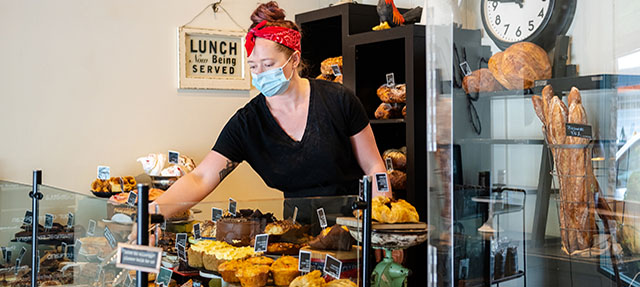At 16.3%, California’s unemployment rate remained stubbornly high in the latest official labor market data (pertaining to mid-May). Job losses across state sectors have leveled off, but California—along with Massachusetts—has the fourth-highest unemployment rate in the nation, after Hawaii, Michigan, and Nevada.
In contrast to California’s essentially unchanged rate, US unemployment dropped by 1.4 points between April and May. Similarly, while consumer spending dropped comparably in California and the rest of the nation (36% vs. 33%, respectively) from January to the end of March, it has rebounded by only about half in California, compared to nearly three-quarters nationally. This slow rebound means that jobs—and individual earnings—have increased more slowly.
The employment picture may be worse than the unemployment rate indicates. California labor force participation declined in May: about 85,000 fewer individuals were either working or looking for work. The labor force participation rate (59.3%) is lower than at any point since 1976. Laid-off workers who are expecting to be recalled by their employers are not counted as “looking for work”; others may have stopped searching while so many businesses are closed.
In addition, some temporarily laid-off workers have been misclassified as employed. If we count these workers as unemployed (many are receiving unemployment benefits and/or have no guarantee of returning to work), California’s unemployment rate could be over 19% by our rough estimate. California’s recovery will be shaped by whether and when businesses can recall workers; at the end of May, about 70% of those filing for unemployment expected to return to their jobs.
In many Bay Area metro areas, where relatively large shares of jobs can be done remotely, unemployment rates are holding steady and continue to be among the lowest in the state. The unemployment rate remains high in the Los Angeles metro area and in many parts of the Central Valley. But some Central Valley metro areas—Merced, Fresno, Madera, Modesto, Stockton, and Visalia—saw notable improvements in the past month. Salinas and Santa Cruz also improved. However, these same areas experienced declines in the labor force, improving the unemployment rate without improving individuals’ job prospects.
Overall, California gained only 142,000 jobs between April and May—just 5% of the 2.6 million jobs lost between February and April. Construction added the most jobs (75,000), followed by accommodation and food service (66,700), and health care (45,300). But government jobs dropped substantially (by 95,800), as the economic downturn began to affect state and local budgets. And two hard-hit sectors have not yet rebounded substantively: jobs increased 1.1% in “other services” (a broad category including automotive repair, personal care, and dry cleaning) and decreased 1.1% in arts and recreation.
Across most regions and sectors, the April-to-May changes show that declines are levelling off. Nevertheless, unemployment remains higher than at any point since the Great Depression, and many of the policy supports to businesses and unemployed workers are set to expire this summer.
California has taken additional steps toward reopening its economy since May, and this may bode well for the estimated 3 million Californians who are unemployed. However, early evidence shows that state-level reopenings have had little impact on local employment, which suggests that consumer spending and confidence remains linked to COVID-related health concerns. Given the continued spread of the virus, California’s economy may be slow to recover, and policymakers should consider expanding assistance to laid-off workers and struggling businesses. State efforts to extend unemployment insurance in the recent budget agreement are a step in the right direction.





